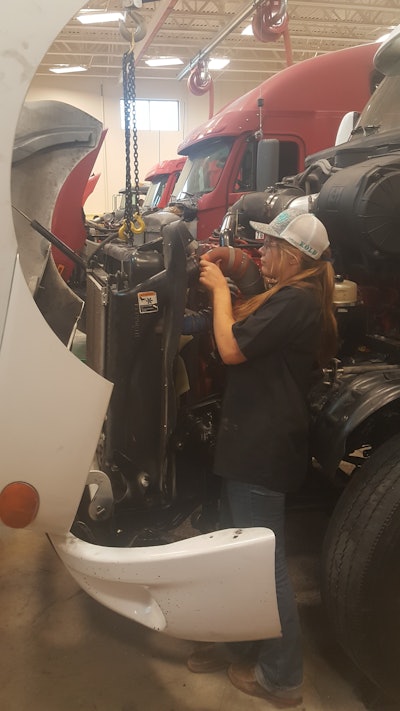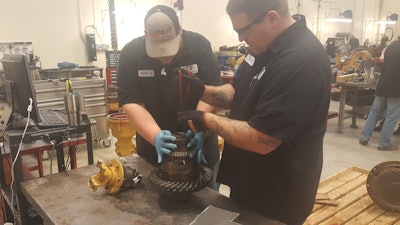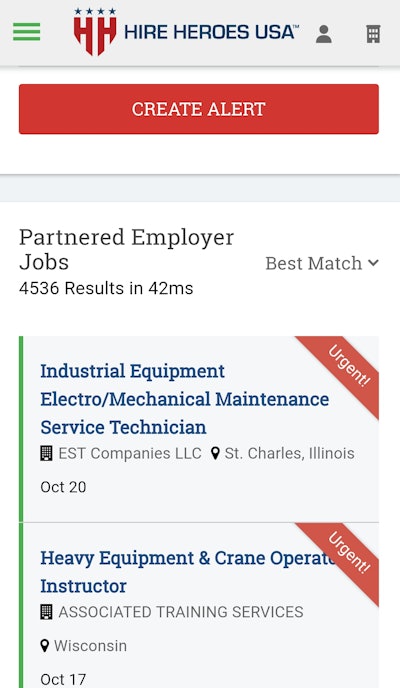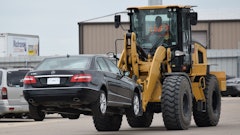
By Gregg Wartgow, Contributing Editor
The construction-equipment technician shortage has been a growing problem for the past decade or two. Now, with an aging workforce of technicians and equipment managers setting their sights on retirement, finding a solution is becoming urgent.
According to equipment dealer Diane Benck, there are a few things the construction industry needs to recognize. First, the general perception that the machinery repair profession is dark, dirty and dangerous needs to change. Secondly, the equipment triangle must work together to help change that perception. Thirdly, a more diverse workforce is needed to help properly staff both equipment dealerships and construction companies.
Benck is the second-generation owner of West Side Tractor Sales Co., a 10-store John Deere dealership serving Indiana, Northern Illinois and Southern Michigan. Benck spoke at AEMP’s SHIFT Conference in October 2018. She pointed to a 2015 study conducted by The College of William & Mary on behalf of the Associated Equipment Distributors (AED), a national association comprising roughly 750 dealers and manufacturers. That study estimated that the technician shortage was costing the U.S. heavy equipment distribution industry roughly $2.4 billion a year in lost revenue. Today, with the economy strengthening and an infrastructure bill possibly on the horizon, those losses could grow even more disheartening.
To help reinforce the industry’s  Simple demographics suggest the construction industry should look to assemble a more diverse workforce that also includes women.Western Dakota Tech
Simple demographics suggest the construction industry should look to assemble a more diverse workforce that also includes women.Western Dakota Tech
For instance, it is generally perceived that Generation Z, born between 1995 and 2010, is strongly motivated by job security and good pay. Plus, unlike with millennials who are perceived to greatly value teamwork, Generation Z likes to work more independently. These workers also like to multi-task and are very digital-savvy. As the construction industry accelerates toward high-tech equipment, a career in machinery repair could be quite appealing to this younger generation of worker.
In addition to her role at West Side Tractor Sales, Benck is also serving as the first-ever chairwoman of AED. One of AED’s top four priorities is to address the technician shortage. The association is working diligently to accredit more schools to help ensure that more students receive proper basic technician training. Roughly 40 high schools and colleges are already accredited. AED hopes to increase that number by more than 60% in 2019. The recent reauthorization of the Carl D. Perkins Career & Technical Education Act (Perkins V) should help by providing additional funding to schools.
Is government listening?
Kate Fox Wood, director of infrastructure policy for the Association of Equipment Manufacturers (AEM) also spoke at the SHIFT Conference. Wood supported Benck’s strategy of equipment triangle cooperation in recruiting new technicians. While federal workforce-development funding levels have risen, the construction industry recognizes that resources remain scant.
Federal initiatives such as the Workforce Innovation & Opportunity Act (WIOA) and Perkins V represent two steps in the right direction. One helpful aspect of Perkins V is that employers now have a more influential say in how funding gets distributed at the local level. That’s why it is important for industry to speak in a single, unified voice.
“The structure of the new Perkins law remains largely the same, although there have been a couple of changes,” says Jarrod Nagurka, advocacy and public affairs manager at the Association for Career & Technical Education (ACTE). “One change is that a program must submit a local needs assessment and update it every couple of years. This assessment identifies what the labor needs of a local community are. Many of the spending decisions are driven by this local needs assessment.”
Nagurka points out that the official name of Perkins V is “The Strengthening Career and Technical Education for the 21st Century Act” (H.R. 2353), which was signed into law in July 2018. While this new law doesn’t go into effect until July 2019, Nagurka says there is a lot going on right now, including the completion of the local needs assessments. Over the next several months, businesses should be opening up dialogue with local grant recipients. “This is a big opportunity for businesses to make sure programs are aware of labor needs and what the opportunities for students are,” Nagurka says.
Vo-tech’s relentless uphill trek
Nagurka is optimistic that the reauthorized Perkins law will help steer more people toward technical careers. One can never be certain, though, especially when funding is such a big component. While funding for vo-tech programs increased with Perkins V, the totals still lag behind levels from before the 2008-9 recession.
One way the new law could help is through career guidance. “Previously, Perkins funds could not be used for students below 7th grade,” Nagurka points out. “Now funding can be used for students in the ‘middle grades’ which is as low as 5th grade. Additionally, some required uses of funds include career exploration as well as integrating academics with CTE, which can help expose more students to technical careers.”
In addition to federal funding initiatives like Perkins V and WIOA, there are also many instances where state and local programs are helping the construction industry attract and train new workers. Dan Ammon, CEM, points to one in South Dakota.
T. Denny Sanford, a wealthy businessman and philanthropist, made a $25 million contribution to help launch the Build Dakota scholarship fund. The South Dakota Future Fund kicked in another $25 million. Scholarships are awarded to skilled students entering high-demand workforce programs at South Dakota technical institutes.
“Students can have 100% of their two-year college paid for if they stay and work in South Dakota for three years after they graduate,” Ammon explains. “We usually have a couple students every semester who are on a Build Dakota scholarship. They walk away a couple of years later – free and clear – and join the industry and start making good money.”
Ammon has been in the industry a long time. He came up the ranks as a diesel technician before eventually becoming a fleet manager. Since January 2018, he has been the diesel technology program co-director at Western Dakota Tech.
Ammon thinks back to the 1980s and 90s when many high school students, including himself, were steered toward a four-year college, often without contemplating what the students really wanted to do. “My blue-collar parents said I should go to college so I could get a job where I didn’t have to work as hard as they did,” Ammon relates. In time, shop classes started falling by the wayside, and the supply of new technicians began to dwindle.
Ammon is cautiously optimistic that things could be turning around. Enrollment in his diesel technology program is up. He credits celebrities such as Mike Rowe for helping call attention to the money-making potential of certain vocational careers. He credits scholarship funds like Build Dakota. Ammon also credits local construction industry companies for getting directly involved in the grassroots effort to cultivate new technicians.
“There are equipment dealerships that help pay some of a student’s tuition if the student comes to work for them,” Ammon says. “Other dealers pay their student employees a lower hourly wage, but supplement that with some kind of monthly bonus to be used toward their education.”
Colleges like Western Dakota Tech work closely with employers to fill positions. The problem Even though enrollment in Western Dakota Tech’s diesel technology program is on the upswing, there still aren’t enough graduating technicians to fill all of the open positions.Western Dakota Tech
Even though enrollment in Western Dakota Tech’s diesel technology program is on the upswing, there still aren’t enough graduating technicians to fill all of the open positions.Western Dakota Tech
“Everyone wants a seasoned, diagnostic-level tech,” Ammon says. “But not every student is there right after graduation. I’ve only been here (Western Dakota Tech) for a year, so it’s a work in progress. We’d like to be able to offer an advanced-level program, but we aren’t quite there yet. With a program like ours, you need some expensive training aids like engines and trucks and equipment.”
Ammon has reasons to be encouraged, though. Enrollment is on the uptick, which should catch the attention of school administrators. Both the state of South Dakota and the federal government are placing increased emphasis on technical careers, leading to increasing sources of funding. Finally, the construction industry recognizes that it has a vested interest in helping close the technician skill gap.
“We (schools) need help from all three sides of the equipment triangle,” Ammon says. “We are all broke teachers and need expensive toys to be able to teach our hands-on classes. We’re fortunate that we get donations and other assistance from manufacturers, dealers and construction companies.”
Ammon says that his ability to put forth a high-quality, hands-on class deserves partial credit for the increase in enrollment. Speaking of enrollment, Ammon is further encouraged by the diversity of his typical classroom. Ages typically range from 16 to 36. Some students are military veterans, others are fresh out of high school, and others are changing careers.
“I’m seeing everything from farmers and ranch kids to students who love computers,” Ammon relates. “They’re all great people and great students. Some love engines and machines, and others just like taking things apart and learning something new.”
As dealer Diane Benck pointed out earlier, it’s going to take all kinds to close the technician gap. Closing the gap is one thing – keeping it closed is another. When catering to a more diverse, somewhat different workforce, construction industry companies need to think about how they’ll foster employee loyalty. Ammon says the younger generation especially wants to feel appreciated. Continuing education and training go a long way.
“Many dealerships have this figured out, but construction companies need to invest in their technicians’ training, too,” Ammon says. “You need to keep new employees energized. Send them to a service school every once in a while, or maybe bring in some training resources to teach them some new things. Internal training can be very powerful, too.”
Local, grassroots efforts are key
Raising awareness of the opportunities in construction equipment repair largely needs to happen at the grassroots level, one school and industry employer at a time.
Branch Civil, which offers a dynamic range of services including heavy civil construction, design-build and site development, is a good example of a company that is active with grassroots outreach. Branch Civil serves clients in Virginia, West Virginia and the Carolinas.
As part of a workforce development initiative, Branch Civil is partnering with HopeTree Academy to develop a job shadowing program. The partnership aims to spark a student’s interest in certain careers. HopeTree Academy is a private day school in Salem, Virginia, that provides a safe and secure educational environment for students with unique educational needs. These often at-risk and in-crisis students grow emotionally and socially, and develop academic and job skills while connecting with vital resources.
Chris Caldwell, CEM, Branch Civil’s equipment superintendent, is working with HopeTree Academy to support their fundraisers. “Students have visited our facility to take a tour and see what we do,” Caldwell says. Branch Civil has also donated a pickup truck and Snap-on diagnostic tool to the auto mechanics department.
Among its other fundraising efforts, Branch Civil participated in the construction of a new Little League baseball field and a soccer field. The company also participated in a unique community event called Touch-A-Truck where local companies and organizations bring in a variety of trucks (i.e. fire trucks, utility boom trucks) for children to explore and learn about. Branch Civil brought in one of its fully equipped mobile maintenance vehicles. “That truck had everything including a crane, welder and lights, along with all the tools a technician would need in the field,” Caldwell tells.
In Michigan, Sachse Construction has partnered with Junior Achievement of Southeastern Michigan to host a one-day construction academy for 500 Detroit-area high school students. Sachse Construction Academy provides exposure to various skilled job opportunities while also allowing for hands-on training with skilled professionals. Students can also meet with labor unions and vocational schools to talk about different career opportunities.
North of the U.S. border, Canadian construction companies have also been facing a technician shortage. Ken Burke, CEM, is a longtime industry professional who has been living in Canada for years. He says the government has woken up to the economy’s desperate need for skilled tradespeople, and a slew of programs are helping to fuel interest in careers like engine repair.
“Provinces drive the car where education and funding are concerned,” says Burke, deputy operations manager for Bechtel Equipment Operations. “In some of the provinces, something known as an RAP Program has been effective. RAP, which stands for rapid access, enables companies to bring high school students in to give them some exposure to the trade. From there students often enroll in secondary or post-secondary education.”
Another program gaining momentum in the Canadian province of Alberta is Skills Canada. Students compete locally, provincially and nationally in a variety of skills competitions ranging from carpentry to baking to machining. Construction equipment manufacturers often get involved with the competitions by displaying equipment for students to look at and hopefully become inspired by. Here in the states, SkillsUSA operates similarly. Both SkillsUSA and Skills Canada are members of World Skills International.
A Canadian organization Burke is especially passionate about is Women Building Futures. WBF helps prepare women for economically prosperous careers in industries where women have historically been under-represented, such as construction. In many instances, the women are single mothers and/or looking for a new career.
After undergoing a rigorous screening process and running through some coursework, each woman does a paid work term with the various sponsoring companies. The women get to see if any of the sponsoring companies would be a good fit for them to seek ongoing employment, and vice versa. The sponsoring companies also get some of their initial investment back in the form of a government education grant.
“Just in the past couple of years, WBF started a program for heavy industrial technicians,” Burke points out. “There were something like eight candidates, which was great for the first year. With the complexity of equipment nowadays, fixing it is more about brains than brawn. Technicians need a very methodical approach. Generally speaking, women have a great aptitude for this and can make for great technicians both today and tomorrow.”
Like others have stated in this article, Burke is convinced that the construction industry needs a more well-rounded workforce to continue thriving into the future. Programs like WBF that cater to women – along with efforts that cater to minority groups, military veterans and other “unconventional” demographics – will be required to assemble that diverse workforce. An “all of the above” strategy is what is needed, and what some in the construction industry are already doing. With so much at stake, the industry can’t afford not to.
 In two years, about 16,000 veterans have gotten jobs through working with Hire Heroes USA.
In two years, about 16,000 veterans have gotten jobs through working with Hire Heroes USA.



























